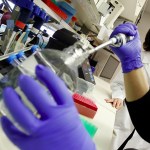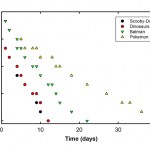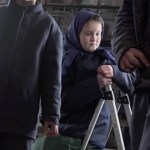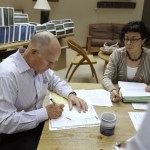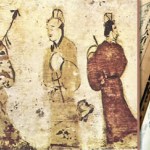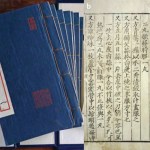Science
The NY Times has put together a lovely illustrated story about data collection on Greenland. The story is prettily terrifying, though. The ice is melting, and forming lakes of liquid water on the surface of the ice cap, which then drains away in fast-running rivers that cut deeper into the ice and then drain into holes that run even deeper into the glacier -- it's a dangerous place, and if you fall in, you'll be swept away and instantly dumped into a pit. It also means the ice sheet is porous and riddled with rot already.
In addition to the personal terror for the researchers, this work is…
Somebody in my social media feeds passed along a link to this interview with Berkeley professor Daniel Boyarin about "the humanities," at NPR's science-y blog. This is, of course, relevant to my interests, but sadly, but while it's a short piece, it contains a lot to hate.
For one thing, after the dismissive one-two of "so-called 'scientific methods'" (Scare quotes! "So-called"! Two great tastes that taste great together!) in the process of trying to re-brand "the humanities" as "the human sciences," Boyarin offers the following on methodology:
The primary method for the study of humans…
I'm a clinician, but I'm actually also a translational scientist. It's not uncommon for those of us in medicine involved in some combination of basic and clinical research to argue about exactly what that means. The idea is translational science is supposed to be the process of "translating" basic science discoveries into the laboratory into medicine, be it in the form of drugs, treatments, surgical procedures, laboratory tests, diagnostic tests, or anything else that physicians use to diagnose and treat human disease. Trying to straddle the two worlds, to turn discoveries in basic science…
I like to point out from time to time that arguably the most striking difference between science-based medicine (and the evidence-based medicine from which we distinguish it) and alternative medicine, "complementary and alternative medicine" (CAM), or (as it's called now) "integrative medicine" is a concerted effort to change practice for the better based on science and evidence. In other words, in SBM, we are continually doing studies to improve practice. These studies take on two general forms: Comparing new treatments with old to determine if the new treatments work better and, as has…
I consider posts like the one I'm writing now to be public service, an obligation. There are times when I don't want to do them, when they become so sadly, depressingly repetitive in overall outline (and, unfortunately, likely outcome) that it takes an effort to begin. However, given that October is Breast Cancer Awareness Month and as a result these sorts of stories seem to pop out of the woodwork this time of year, I feel I must. It doesn't matter that I just discussed another one of these cases a mere month ago. This time around, the article appears (as is so frequently the case) in The…
A few years back, I did a couple of posts on the physics of a sad balloon (that is, a helium balloon that can no longer lift itself up to the ceiling), the first on simple buoyancy, the second on how long it takes for the helium to leak out. These were based on only a couple of data points, though, and it's always risky to extrapolate too far from just two points.
Of course, in a house with two kids, we have helium balloons show up with some regularity, and SteelyKid's birthday this year provided a bounty of them-- four shiny Mylar balloons, bearing cheerful images of Scooby-Doo, some cartoon…
Two of the great "icons"—if you can call them "great" given that they're icons but hardly "great"—of the antivaccine movement are Andrew Wakefield and Jenny McCarthy. Over the last decade, they have arguably been the most influential people in the antivaccine movement. The reasons are simple. Let's look at Jenny McCarthy first. In 2007, when her child Evan was diagnosed with autism and she blamed MMR vaccine for it, McCarthy became virtually overnight the single most famous celebrity antivaccine advocate. With her then-boyfriend Jim Carrey, in 2008 she led an antivaccine march on Washington…
If there's one thing I've been consistent about, it's that, however ridiculous all the other woo I routinely discuss here is—homeopathy, reiki, reflexology, I'm talking to you and your friends—herbal medicine and supplements might have value because they might have a physiological effect that is beneficial in treating or preventing disease. Of course, if that's the case, it's because the herb or supplement contains chemicals that act as drugs. They're "dirty" drugs in that they are mixed with all sorts of other substances in the herb or supplement that might or might not have effects, which…
Oh, no, Nature. Not you. Not again.
It wasn't enough that you were busted shilling for traditional Chinese medicine with a big, glossy advertising supplement a few years ago. I thought you had learned your lesson after that, as you didn't do it again. Maybe I was wrong. Granted, your offense this time is not quite as bad as accepting cash from Saishunkan Pharmaceutical Co., ltd. and the Kitasato University Oriental Medicine Research Center to put together what was in essence pure propaganda for quackery, but, on the other hand, I do have to be worried that you might be thinking of backsliding…
One of the more depressing topics that I regularly write about includes of analyses of news stories of children with cancer whose parents decided to stop science-based treatment (usually the chemotherapy) and use quackery instead. There are, of course, variations on this theme, but these stories take form that generally resembles this outline: A child is diagnosed with a highly treatable cancer with an excellent cure rate. Standard science-based treatment is begun, but the child suffers severe side effects from the chemotherapy. After an incomplete course of chemotherapy, the parents, alarmed…
For the 42nd installment of this photo-a-day thing, it seems appropriate to try to do some SCIENCE! to get an Answer. So, here's a composite of a bunch of images I took yesterday in order to investigate something:
Graph paper shot with several different lenses, to look for distortion of the images.
OK, this needs some explanation...
So, I do a lot of shooting with moderately wide-angle lenses (either a 10-18mm zoom or the 24mm fixed "pancake" lens), because SteelyKid and The Pip tend to want to be right on top of me a lot of the time, and it's hard to get good pictures with them fully in…
When last I discussed the cruel sham that is the tide of "right-to-try" laws that has been flowing through state legislatures to become law over the last year and a half. "Right-to-try" laws, as I pointed out when I first noted the earliest ones being promoted in Colorado, Louisiana, Arizona, and Missouri, referring to them as Dallas Buyers Club bills based on their seeming inspiration from that movie and pointing out how they are very, very bad policy that, contrary to the claims of its proponents, are far more likely to harm patients than help them. In every state in which such bills have…
Last week, in response to the awarding of the Nobel Prize in Physiology or Medicine to Chinese scientist Youyou Tu, who isolated Artemisinin and validated it as a useful treatment for malaria back in the 1970s, I pointed out that the discovery was a triumph of natural products pharmacology, not of traditional Chinese medicine (TCM). So did Scott Gavura, a pharmacist who blogs at my favorite other blog, Science-Based Medicine, who also emphasized that the path from TCM remedy for fever to pill used to treat malaria was the very model of how pharmacologists isolate medicines from plants.…
Friday was yet another heavy kid-wrangling day, as the Pip had a minor surgical procedure in the early morning, which required general anaesthesia. This was done before 9am, but we had to keep him home from school for the day to watch for ill effects. Of which there were none, so he and I went out to the local science museum for a bit, to break up the cartoon-watching that was the other primary activity of the day.
I've posted a bunch of cute-kid photos already, though, so here's one that's just science museum stuff:
Smoke tornado at MiSci.
That's the artificial tornado exhibit-- a…
Over the years, I've frequently made the points that the vast majority of physicians are not scientists and, in fact, that many of them suffer from a severe case of Dunning-Kruger when it comes to science. Even going back to the very early history of this blog, you can find examples, the most common of which seemed to be physicians denying evolution and embracing creationism. Of these, the doctor I wrote about most frequently back in the day was the creationist neurosurgeon Michael Egnor, but with the onset of the 2016 Presidential race there's been a new creationist neurosurgeon in town with…
In yesterday's crude astrophotography post, I mentioned that the conjunction of Venus and the Moon would be closer this morning, but I took a shot of it yesterday because there's no telling with the weather here this time of year. When I first went outside this morning, though, the sky was beautiful and clear and I said "Wow, that'll be a great shot after all."
Then I went inside to eat breakfast, and when I came back out, clouds had rolled in.
There were occasional breaks, though, and I did manage to get a fortuitous alignment of two of those with the bodies in question. which let me make…
Yesterday, I wrote about the winner of the Nobel Prize in Physiology or Medicine, Youyou Tu, who, after screening 2,000 herbal treatments from traditional Chinese medicine (TCM) for anti-malaria activity, finally discovered Artemisinin. She isolated it from the plant in which it is found, using modern chemistry to isolate it, purify it, and later chemically modify it to make it more active against malaria. Tu deserved the Nobel Prize for her years of screening. As I pointed out, contrary to how the awarding of the Nobel Prize to Tu is being spun, it is not a validation of TCM, but rather of…
One of the few problems with the new camera is that the Canon software that talks to it only runs on my laptop, not my home desktop. This is an issue partly because the laptop has less disk space (I got it with the biggest SSD available a few years ago, which is small compared to the spinny-disk drives in the desktop), but a bigger issue for image processing is the display, which shifts colors dramatically as you change the viewing angle. This isn't a big issue for daylight photos of the kids, where the camera does pretty well already and the GIMP auto-level tool handles the few color issues…
Earlier this week, the Nobel Prize in Physiology or Medicine was awarded to Youyou Tu for her discovery of the anti-malaria compound Artemisinin, as well as to William C. Campbell and Satoshi Ōmura for their discovery of a novel therapy for roundworm. Artemisinin, as some of you might know, is a compound derived from traditional Chinese medicine, which is why, to my irritation, it didn't take long for headlines like How traditional Chinese medicine finally won its Nobel Prize, What the 2015 Nobel Prizes mean for traditional Chinese medicine, and A Medical Breakthrough Made Possible By Ancient…
Anger is an energy, as a certain old punk sang back in the 1980s. It can even be a great motivator, such as when anger overtakes us for injustice or over crimes. Anger, however, is not a particularly good intellectual tool, nor does it help in analyzing science.
Which reminds me: J.B. Handley is back.
You have to be a bit of a long time reader—OK, a really long time reader—to remember that Mr. Handley's antics used to be a regular topic of this blog. After all, he and his wife were the founders of a long-standing antivaccine group, Generation Rescue. It was an antivaccine group founded on the…
